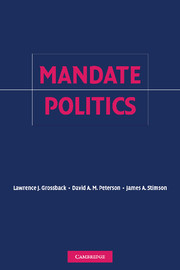Book contents
- Frontmatter
- Contents
- List of Figures
- List of Tables
- Preface
- Acknowledgments
- 1 A Single Time in a Single Place
- 2 The Evolution of Mandates
- 3 Members of Congress Respond
- 4 The Pattern of Congressional Response
- 5 Consequences
- 6 The Irresistible Meets the Unmovable
- 7 Conclusion: A Mandate View of Normal American Politics
- Bibliography
- Index
Preface
Published online by Cambridge University Press: 14 August 2009
- Frontmatter
- Contents
- List of Figures
- List of Tables
- Preface
- Acknowledgments
- 1 A Single Time in a Single Place
- 2 The Evolution of Mandates
- 3 Members of Congress Respond
- 4 The Pattern of Congressional Response
- 5 Consequences
- 6 The Irresistible Meets the Unmovable
- 7 Conclusion: A Mandate View of Normal American Politics
- Bibliography
- Index
Summary
We confess. We are sinners. According to the gospel of political methodology, one should never let method determine choice of topics to investigate. The prohibition is so sensible that it needs no explanation. And yet this is exactly what we did. In the spring of 1997, four of us sat around a table in a seminar room in Minneapolis and asked the question, “What would be a good application of the duration modeling techniques that we had been studying together?”
In a few minutes of conversation, we spun a story about observing members of Congress faced with a Washington consensus that the election just passed had carried a voter mandate. We asked what the reaction should look like and, because this was a methods course and we are social scientists, how we could model it. Although we may not have known it then, the question of the impact of perceived mandates had been investigated before. Importantly, however, the tools used and assumptions made were blunt. Scholars asked if the year following a mandate was different from the year that preceded it, concluding that it was not. The duration model, in contrast, focused on a temporary response that had run its course, as we now know, by midyear – and lost most of its force well before that. In this case, the tool matters.
- Type
- Chapter
- Information
- Mandate Politics , pp. xi - xivPublisher: Cambridge University PressPrint publication year: 2006

